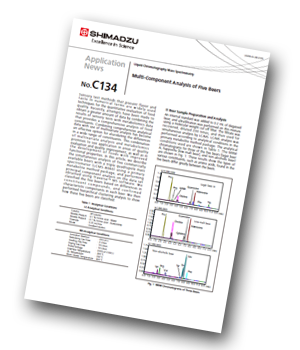Shimadzu has produced an application note describing the simultaneous analysis of five commercially available beers with a triple quadrupole mass spectrometer (LCMS-8060) using a primary metabolite method package, and performing principal component analysis on the data set obtained using TraverseTM MS software.
 Introduction
Introduction
Sensory test methods that present flavour and taste in numerical terms are widely used techniques for the quantitative evaluation of food quality. Recently, attempts have been made to obtain a greater amount of data by combining the results of sensory tets with metabolomics data that provides a comprehensive analysis of food constituents. Combining comprehensive analytical data with use of multivariate analysis has become an effective option for elucidating the differences in a wide range of consituents.
Experimental
The beers were classified based on differences in constituent compounds and confirmed characteristic components in each beer. Hierarchical clustering analysis was then performed to show how the five beers were classified. Simultaneous LC-MS was performed according to the analytical conditions in the primary metabolite method package.
Results and Discussion
Hierarchical clustering analysis provides a visual representation of the degree of similarity between the beers in terms of their constituents. Performing a comprehensive analysis of food constituents in this way and combining it with multivariate analysis makes it easy to evaluate which constituents affect food quality and function.
Conclusion
This combination of comprehensive simultaneous and multivariate analysis is expected to become more commonly used for quality evaluation of food in the future.




